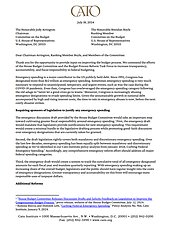Dear Chairman Arrington, Ranking Member Boyle, and Members of the Committee:
Thank you for the opportunity to provide input on improving the budget process. We commend the efforts of the House Budget Committee and the Budget Process Reform Task Force to increase transparency, accountability, and fiscal responsibility in federal budgeting.
Emergency spending is a major contributor to the US publicly held debt. Since 1992, Congress has designated more than $12 trillion as emergency spending. Sometimes emergency spending is very much necessary to respond to unanticipated, temporary, and urgent events, such as was the case during the COVID-19 pandemic. Even then, Congress has overleveraged the emergency spending category following the old adage to “never let a good crisis go to waste.’ Moreover, Congress is increasingly abusing emergency designations to evade spending limits. Given the unsustainable growth in national debt accompanied by high and rising interest costs, the time to rein in emergency abuses is now, before the next costly disaster strikes.
Requiring sponsors of legislation to justify any emergency spending
The emergency discussion draft provided by the House Budget Committee would take an important step toward cultivating greater fiscal responsibility around emergency spending.1 First, the emergency draft would mandate that legislators provide justifications for new emergency spending. This requirement would create a minimal hurdle in the legislative drafting process while promoting good-faith discussion over emergency designations that are currently taken for granted.
Second, the draft legislation rightly covers both mandatory and discretionary emergency spending. Over the last few decades, emergency spending has been equally split between mandatory and discretionary spending as we’ve identified in our Cato Institute policy analysis from January 2024, Curbing Federal Emergency Spending.2 Accordingly, any comprehensive emergency reform effort should address all major federal spending categories.
Third, the emergency draft would create a system to track the cumulative total of all emergency designated amounts for each fiscal year and mandate quarterly reporting. With emergency spending making up an increasing share of the overall budget, legislators and the public should have regular insight into the costs of emergency designations. Greater transparency and accountability on this front will encourage more responsible uses of taxpayer dollars.
Additional Reforms
Along with implementing the reforms suggested in the emergency discussion draft, here are four other emergency spending reforms to strengthen budgetary guardrails and prevent emergency abuse:
- Offset emergency spending
Congress should consider a budget enforcement mechanism to offset new emergency expenditures, preferably at the same time as emergency spending takes place or at least over the near-term future with spending reductions to lesser priorities in the budget. Under the current system, legislators leverage emergencies as a pretext to pass budget-breaking initiatives with no consideration for future budget restraint. 3 Establishing an offsetting mechanism gives appropriators the flexibility to address emergencies when necessary while also incentivizing forward-thinking budget planning.
- End executive emergency declarations after 30 days
Under the National Emergency Act, the president can declare a national emergency, formalize a state of emergency, and unlock extraordinary emergency powers. Both President Trump (border wall) and President Biden (student loan debt) leveraged emergency powers to bypass the democratic process at the expense of the taxpayer. Creating a “shot clock” where emergency declarations automatically expire unless extended by Congress would limit costly executive overreach and challenge our never-ending state of emergency.4
- Enhance transparency over executive emergency spending
The National Emergency Act requires the president to submit emergency expenditure reports to Congress during and/or after an emergency. The intention is to provide transparency and accountability to aid Congress in policing executive abuses of emergency funds. The current system is convoluted, and reports are not easily available or detailed.5 Congress should hold the executive accountable and make these expenditure reports both more detailed and publicly available. Concerned citizens and legislators deserve to know how the executive expends taxpayer dollars during emergencies.
- Correct the budget baseline distortion
Congress uses the Congressional Budget Office (CBO) baseline to benchmark new proposals. Under the Balanced Budget and Emergency Deficit Control Act, the CBO must assume discretionary appropriations, even if for one-time emergency priorities, grow each year with inflation. This practice creates a ratchet effect, building an expectation for higher spending and distorting the budgetary picture. Exempting emergency spending from the baseline better reflects the reality that emergency designations should be temporary, one-time expenditures.6
Improving the Congressional Budget Process
Congress has a habit of playing fast and loose with emergency spending, which has deleterious effects on deficits and debt. Legislators have the opportunity and obligation to establish sensible emergency guardrails now before the next crisis strikes. The House Budget Committee is taking an important step toward increasing transparency and accountability over emergency spending with the current version of its discussion draft on requiring sponsors of legislation to justify any emergency spending.7

This work is licensed under a Creative Commons Attribution-NonCommercial-ShareAlike 4.0 International License.

